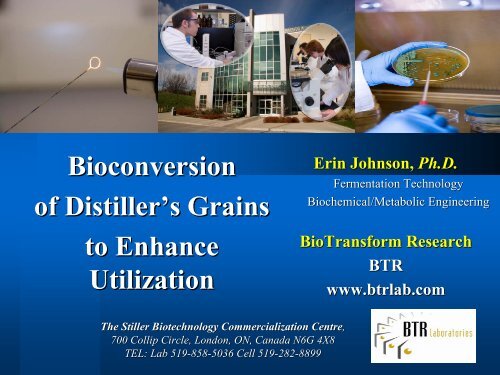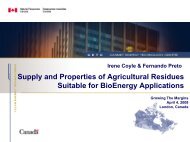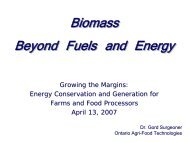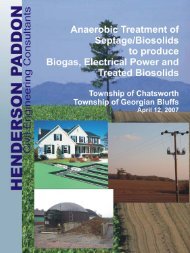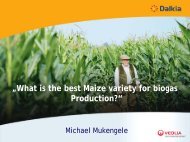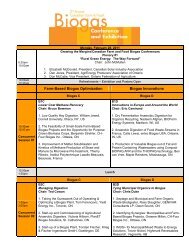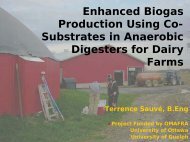Bioconversion of Distillers Grains to Enhance Utilization
Bioconversion of Distillers Grains to Enhance Utilization
Bioconversion of Distillers Grains to Enhance Utilization
Create successful ePaper yourself
Turn your PDF publications into a flip-book with our unique Google optimized e-Paper software.
2005 Annual World Ethanol Production~ 46 billion L (all grades)Richt, RFAEnough <strong>to</strong> Displace ONLY 2% World GasolineConsumption
Total World Ethanol Production for2006 = 8.7 billion gal(33 billion L)46% North America47% BrazilWorld demand for enzymes isexpected <strong>to</strong> rise 6.5 per centannually<strong>to</strong> nearly $5.1 billion in 2009,according <strong>to</strong> a new report.
Canada Bio-Ethanol• Terra Grain Fuels building a 0.150 bill L/yrwheat-fed ethanol plant, Saskatchewan• St Clair Ethanol (Suncor) now largest plantin Canada (Jul 2006, 0.200 bill L/yr)• Applied for expansion permits <strong>to</strong> double• Collingwood Ethanol: 0.050 bill L/yr – wetmill-June 2007• Mid-2008:Rivers<strong>to</strong>ne/Carlyle/DominionEnergy ~ 0.380 bill L/yr ethanol & 0.380 billL/yr bio diesel in AlbertaTotal 2.1 bill L/yr by 2008 in Canada
Bush Touring a DuPont Research Lab• President Bush's goal - reduce gasolineusage by 20% in 10 years through:• alternative fuels & vehicle fuel-economyeconomy• Means expansion <strong>of</strong> US fuel ethanol <strong>to</strong> 133bill L/yr by 2017) -currently ~ 36 bill L/yr• Is there enough US corn for Bush’s s ethanol plan?
Well . . . . .• ‘The Great Corn Rush’ wasalready sweeping theMidwest before the WhiteHouse set its New AmbitiousTargets• Corn growers say “U.S. corn can, at most,supply just 57 bill L/yr by 2015”• "Nobody believes you can hit that kind <strong>of</strong>volume from grain alone in 10 years," said BobDinneen, , president <strong>of</strong> the Renewable FuelsAssociation
Corn Dry-Milling Process Overview20 mill bu CornCorn CleaningHammermillDistillationAlpha-Amylase Enzyme(0.02%)Mix Slurry Premix40-60˚CCO 2 293 kgheatFermentation32˚CCooker 90-120˚CYeast and GlucoamylaseEnzymeMashCoolerBack-setcoolAlpha-Amylase Enzyme(0.04-0.06%)Liquefaction 90˚CSaccharification60˚CGlucoamylaseEnzyme(0.06-0.12%)Ethanol 200mill L/yrWholestillageCoarse solidsCentrifugethin stillageEvapora<strong>to</strong>rsolublessolublesDistiller’s Wet<strong>Grains</strong>Rotary DryerDistiller’sDry <strong>Grains</strong>w/Solubles160,000 MTCond.Distiller’sSolubles
Most Controversial <strong>of</strong> all. . . .• Sudden and massive switch <strong>of</strong> corn cropsfrom Food <strong>to</strong> Fuel• Major dis<strong>to</strong>rtions in world agriculturalmarkets• The US produces about 40% <strong>of</strong> global cornproduction (70% <strong>of</strong> world <strong>to</strong>tal exports)• Ethanol consumed 6% US corn harvest in2000• Now ~20% <strong>of</strong> the US corn harvest• Analysts are predicting by next year, roughly half <strong>of</strong>the entire US crop will go <strong>to</strong> ethanol distilleries
Distiller’s <strong>Grains</strong> Drying Process-Rotary Dryers• Takes ~1/3<strong>to</strong>tal ethanolprocessenergy <strong>to</strong> drywet grain co-product• Leads <strong>to</strong>nutritionalDamage• Hugeoperatingcosts
Value-Added DWGS• Abundant & cheap raw material• High nutritional value <strong>to</strong> start(fat(11%), crude fiber(8%), protein(30%)• Environmental issues resolved• No competition with bio-fuels & human food• Create new products/markets (mono-gastrics)• Capture a sizable increase share <strong>of</strong> existingmarkets (ruminants)• Quality controlled process
What is Solid State Fermentation (SSF)• Growth <strong>of</strong> microorganisms on moist solidparticles• Spaces between particles contain a continuousgas phase with minimal visible water• Majority <strong>of</strong> water is discontinuous and absorbedby solid• 4,000 years old• Considered for enzyme production in 1900s andfor penicillin in the 1940s• Submerged Liquid Fermentation dominated• Revival <strong>of</strong> interest began in 1970s• Theoretical base for SSF technology began <strong>to</strong> beestablished in the 1990s
Solid State Fermentation (SSF)Microbes:• Produceenzymes• Convert fiber• Consumenutrients• Altering pH• Release heat• ConsumeoxygenD.A. Mitchell, 2006
Silage - SSF• Preserve damphay• Lactic acidbacteria producelactic acid -lowers the pH -s<strong>to</strong>ps any ‘nasty’bacteria fromspoiling it• LAB do notproduce <strong>to</strong>xic by-products
Fermented Foods - SSF• 4,000 years old• Rhizopus oligosporous• Transforms cookedsoybeans in<strong>to</strong> the highlyregarded tempeh• Mycelium <strong>of</strong> the fungigrows through thesoybean paste holding it<strong>to</strong>gether – makes sugars• Characteristic chewytexture, whilefermentation gives it adistinctive flavor
Koji - SSF• Steamed rice that has hadkoji-kin, kin, or koji fungispores, cultivated on<strong>to</strong> it(Aspergillusoryzae)• Creates several enzymes asit propagates• Break the starches in ricein<strong>to</strong> sugars• Can be further fermentedby the yeast <strong>to</strong> make sake
Enzymes - SSFProduction <strong>of</strong> enzymes usingSSF:• Food• Pulp & paper• Detergents• Ethanol• Bioremediation• Textiles• Pharmaceuticals• Cosmetics• Natural Health Products
Durand Bioreac<strong>to</strong>r at National Institute <strong>of</strong>Agronomic Research in Dijon France (50L)Durand, 2003
SSF Technology - Advantages• Mechanically/structurally simple, littlepretreatment, less processing energy, lowwater usage, low water activity reduces risk<strong>of</strong> contamination• Some SSF products have more desirableproperties – i.e. spore-basedbiopesticideswith more resistance <strong>to</strong> adverse conditions• Certain enzymes are only induced in SSF• Production <strong>of</strong> metabolite can be muchhigher in concentration in SSF• Usually a different pr<strong>of</strong>ile <strong>of</strong> metabolites inSSF
SSF Technological ChallengesSolid State Bioreac<strong>to</strong>r Design• Morphology <strong>of</strong> fungi sensitive <strong>to</strong> shear &mixing• Sensor and control technology underdeveloped• Difficult <strong>to</strong> model – heterogenity atmicroscale• Particle behavior with fungal hyphaebridging gaps• Mass gas transfer is in voids betweenparticles• Dessication can occur fast• Little research in<strong>to</strong> engineering <strong>to</strong> overcomegradients in heat, pH, moisture and scale-up
SSF Commercialization Examples• Biocon, , India• Food and speciality enzymes began in 1990• Demonstrated production <strong>of</strong> lovastatin(antihypercholesteremicagent), mycophenolic acid(an immunosuppressant), Trichoderma viride spores(biocontrol), fungal proteases (food industry)• Alltech, , US & Mexico• SSF for enzymes - $10-million facility - 200 staff35,000 square-foot plant – Serdan Mexico• Construction <strong>of</strong> a $17.7 million SSF plant inKentucky• Allzyme® from locally grown wheat bran (phytase(byAspergillus niger)
In Summary – BTR Bio-Refining Technology:• Eliminate current drying process <strong>to</strong> reducenutritional damage & energy utilization• Create value-added added nutritional feed fromDDGS• Control & test for consistency & quality• Apply myco<strong>to</strong>xin treatment• No need for enzyme addition – already done• Reduce environmental issues• Alter process <strong>to</strong> target nutritional needs• Platform technology for enzymes, NHP, etc.• Used on other agricultural residues
In Summary – BTR Bio-Refining Technology:• Help <strong>to</strong> stabilize the cost <strong>of</strong> raw materialsfor the feed industry• Create sustainability for the ethanolindustry• Remove bottlenecks in future animalfarming• Increase revenues in Ontario (beef, poultry,pork, milk)• Free up raw materials for energy and food• Increase employment and investmentdollars in Ontario
BTR Labora<strong>to</strong>ries at The Stiller Centre London Ontario. Canada


